Greening the Economy from the Ground Up: How the Minimum Wage Affects Firms’ Pollution Emissions in China
Abstract
1. Introduction
2. Policy Background
3. Research Hypotheses
3.1. The Product Structure Effect
3.2. Technological Innovation Effect
3.3. Managerial Efficiency Effect
3.4. Heterogeneity: The Choreography of Regional Disparities
4. Variables Data and Method
4.1. Variables
4.1.1. Core Explanatory Variable
4.1.2. Dependent Variable
4.1.3. Mechanism Variables
4.1.4. Control Variables
4.2. Data Source
4.2.1. China Industrial Firm Panel Database
4.2.2. China Industrial Firm Pollution Database
4.2.3. District and County Panel Data
4.3. Data Matching
4.4. Method
4.4.1. Baseline Regression Model
4.4.2. Causal Forests Algorithm
4.5. Spatial Correlation Analysis
5. Results
5.1. Baseline Regression Result
5.2. Robust Check
5.2.1. Parallel Trends Assumption
5.2.2. Placebo Test
5.2.3. Change the Spatial Matrix
5.2.4. Addressing Endogeneity Concerns: IV Approach
5.3. Heterogeneity Analysis
5.3.1. Level of Economic Development
5.3.2. Magnitude of Minimum Wage Adjustment
5.3.3. Stringency of Environmental Regulations
5.4. Long-Term Effects
6. Mechanism Test
6.1. Labor Productivity Dynamics
6.2. Cost Pass-Through Effect
6.3. Corporate Governance and Environmental Performance
7. Conclusions and Policy Implication
7.1. Conclusions
7.2. Policy Implication
- (1)
- Balancing Economic and Environmental Goals: Integrated Policy Design: Policymakers should consider an integrated approach when designing labor and environmental policies. For instance, wage policies can be synchronized with environmental regulations to ensure mutual reinforcement. This could involve setting minimum wage levels that also account for environmental performance metrics of firms.
- (2)
- Incentives for Sustainable Practices: Financial incentives should be provided, such as tax breaks or subsidies for firms that achieve both wage compliance and environmental standards. This encourages firms to invest in sustainable technologies and practices without compromising economic viability.
- (3)
- Supporting Firms in Transition: Access to Green Technologies: Access to green technologies should be facilitated through grants, low-interest loans, or public–private partnerships. This support can help firms offset the initial costs of adopting cleaner technologies.
- (4)
- Training and Capacity Building: Training programs for management and workers should be implemented covering the benefits and implementation of green technologies. This helps build internal capacity and supports a smoother transition to sustainable practices.
- (5)
- Gradual Implementation of Wage Hikes: Minimum wage increases should be gradually introduced to give firms time to adjust. Coupled with environmental targets, this phased approach can prevent sudden financial strain and encourage sustainable adjustments.
- (6)
- Targeted Regional Implementation: There should be recognition that due to the heterogeneous impact across regions with varying economic developments, there is an opportunity for calibrated, region-specific wage adjustments. In regions at the cusp of industrial transformation, ensuring wage hikes could serve the dual purpose of enhancing worker welfare and inadvertently catalyzing greener production methods.
- (7)
- Incentivizing Green Corporate Governance: The observed interaction between corporate governance structures and environmental outcomes signals a pressing need to incorporate ESG metrics more firmly within corporate performance evaluations. Offering tax incentives or subsidies to firms that excel in green governance could provide the necessary impetus for more sustainable operations.
- (8)
- Inclusive Policy Formulation: Key stakeholders should be identified and engaged, including industrial bodies, labor unions, and environmental groups, in policy formulation. Joint workshops, feedback sessions, and collaborative policy design initiatives can ensure that wage policies are economically viable and environmentally prudent.
Author Contributions
Funding
Institutional Review Board Statement
Informed Consent Statement
Data Availability Statement
Conflicts of Interest
References
- Garnero, A.; Lucifora, C. Turning a ‘Blind Eye’? Compliance with Minimum Wage Standards and Employment. Economica 2022, 89, 884–907. [Google Scholar] [CrossRef]
- Li, H.; Li, Y.; Guo, L. How does minimum wage affect firm pollution discharges: Evidence from China. J. Clean. Prod. 2023, 414, 137504. [Google Scholar] [CrossRef]
- Grossman, J.B. The impact of the minimum wage on other wages. J. Hum. Resour. 1983, 18, 359–378. [Google Scholar] [CrossRef]
- Harasztosi, P.; Lindner, A. Who pays for the minimum wage? Am. Econ. Rev. 2019, 109, 2693–2727. [Google Scholar] [CrossRef]
- Li, Y.; Kanbur, R.; Lin, C. Minimum wage competition between local governments in China. J. Dev. Stud. 2019, 55, 2479–2494. [Google Scholar] [CrossRef]
- Hart, S.L.; Ahuja, G. Does it pay to be green? An empirical examination of the relationship between emission reduction and firm performance. Bus. Strategy Environ. 1996, 5, 30–37. [Google Scholar] [CrossRef]
- Filene, E.A. The minimum wage and efficiency. Am. Econ. Rev. 1923, 13, 411–415. [Google Scholar]
- Karp, L.; Livernois, J. Using automatic tax changes to control pollution emissions. J. Environ. Econ. Manag. 1994, 27, 38–48. [Google Scholar] [CrossRef]
- King, A.A.; Lenox, M.J. Does it really pay to be green? An empirical study of firm environmental and financial performance: An empirical study of firm environmental and financial performance. J. Ind. Ecol. 2001, 5, 105–116. [Google Scholar] [CrossRef]
- Kong, D.; Zhu, L. Governments’ fiscal squeeze and firms’ pollution emissions: Evidence from a natural experiment in China. Environ. Resour. Econ. 2022, 81, 833–866. [Google Scholar] [CrossRef]
- Lyubich, E.; Shapiro, J.S.; Walker, R. Regulating mismeasured pollution: Implications of firm heterogeneity for environmental policy. In AEA Papers and Proceedings; American Economic Association: Nashville, TN, USA, 2018. [Google Scholar]
- Li, X.; Zhou, Y.M. Offshoring pollution while offshoring production? Strateg. Manag. J. 2017, 38, 2310–2329. [Google Scholar] [CrossRef]
- Nishitani, K.; Kaneko, S.; Fujii, H.; Komatsu, S. Effects of the reduction of pollution emissions on the economic performance of firms: An empirical analysis focusing on demand and productivity. J. Clean. Prod. 2011, 19, 1956–1964. [Google Scholar] [CrossRef]
- Schmitt, J. Explaining the small employment effects of the minimum wage in the United States. Ind. Relat. J. Econ. Soc. 2015, 54, 547–581. [Google Scholar] [CrossRef]
- Schulten, T. Towards a European minimum wage policy? Fair wages and social Europe. Eur. J. Ind. Relat. 2008, 14, 421–439. [Google Scholar] [CrossRef]
- Song, J.; Chen, Y.; Luan, F. Air pollution, water pollution, and robots: Is technology the panacea. J. Environ. Manag. 2023, 330, 117170. [Google Scholar] [CrossRef]
- Silberman, J.I.; Durden, G.C. Determining legislative preferences on the minimum wage: An economic approach. J. Political Econ. 1976, 84, 317–329. [Google Scholar] [CrossRef]
- Kling, C.; Rubin, J. Bankable permits for the control of environmental pollution. J. Public Econ. 1997, 64, 101–115. [Google Scholar] [CrossRef]
- Starr, G.F. Minimum Wage Fixing: An International Review of Practices and Problems; ILO: Geneva, Switzerland, 1981. [Google Scholar]
- Weil, D. Public enforcement/private monitoring: Evaluating a new approach to regulating the minimum wage. ILR Rev. 2005, 58, 238–257. [Google Scholar] [CrossRef]
- Tang, M.; Li, Z.; Hu, F.; Wu, B.; Zhang, R. Market failure, tradable discharge permit, and pollution reduction: Evidence from industrial firms in China. Ecol. Econ. 2021, 189, 107180. [Google Scholar] [CrossRef]
- Stigler, G.J. The economics of minimum wage legislation. Am. Econ. Rev. 1946, 36, 358–365. [Google Scholar]
- Manning, A. The elusive employment effect of the minimum wage. J. Econ. Perspect. 2021, 35, 3–26. [Google Scholar] [CrossRef]
- Zhang, D. Marketization, environmental regulation, and eco-friendly productivity: A Malmquist–Luenberger index for pollution emissions of large Chinese firms. J. Asian Econ. 2021, 76, 101342. [Google Scholar] [CrossRef]
- Zhang, M.-A.; Lu, S.; Zhang, S.; Bai, Y. The unintended consequence of minimum wage hikes: Evidence based on firms’ pollution emission. Energy Econ. 2023, 125, 106857. [Google Scholar] [CrossRef]
- Yang, S.; Jahanger, A.; Hossain, M.R. How effective has the low-carbon city pilot policy been as an environmental intervention in curbing pollution? Evidence from Chinese industrial enterprises. Energy Econ. 2023, 118, 106523. [Google Scholar] [CrossRef]
- Welch, F. Minimum wage legislation in the United States. Econ. Inq. 1974, 12, 285–318. [Google Scholar] [CrossRef]
- Zhao, Y.; Mao, J. Energy effects of non-energy policies: Minimum wage standard and enterprise energy efficiency in China. Resour. Policy 2022, 79, 102953. [Google Scholar] [CrossRef]
- Kang, C.-C.; Khan, H.A.; Feng, C.-M.; Wu, C.-C. Efficiency evaluation of bus transit firms with and without consideration of environmental air-pollution emissions. Transp. Res. Part D Transp. Environ. 2017, 50, 505–519. [Google Scholar] [CrossRef]
- Reich, M.; Allegretto, S.; Godoey, A. Seattle’s Minimum Wage Experience 2015–16; IRLE: Berkeley, CA, USA, 2017; SSRN 3043388. [Google Scholar]
- Pollin, R. Economic prospects: Making the federal minimum wage a living wage. In New Labor Forum; Sage Publications, Inc.: New York, NY, USA, 2007. [Google Scholar]

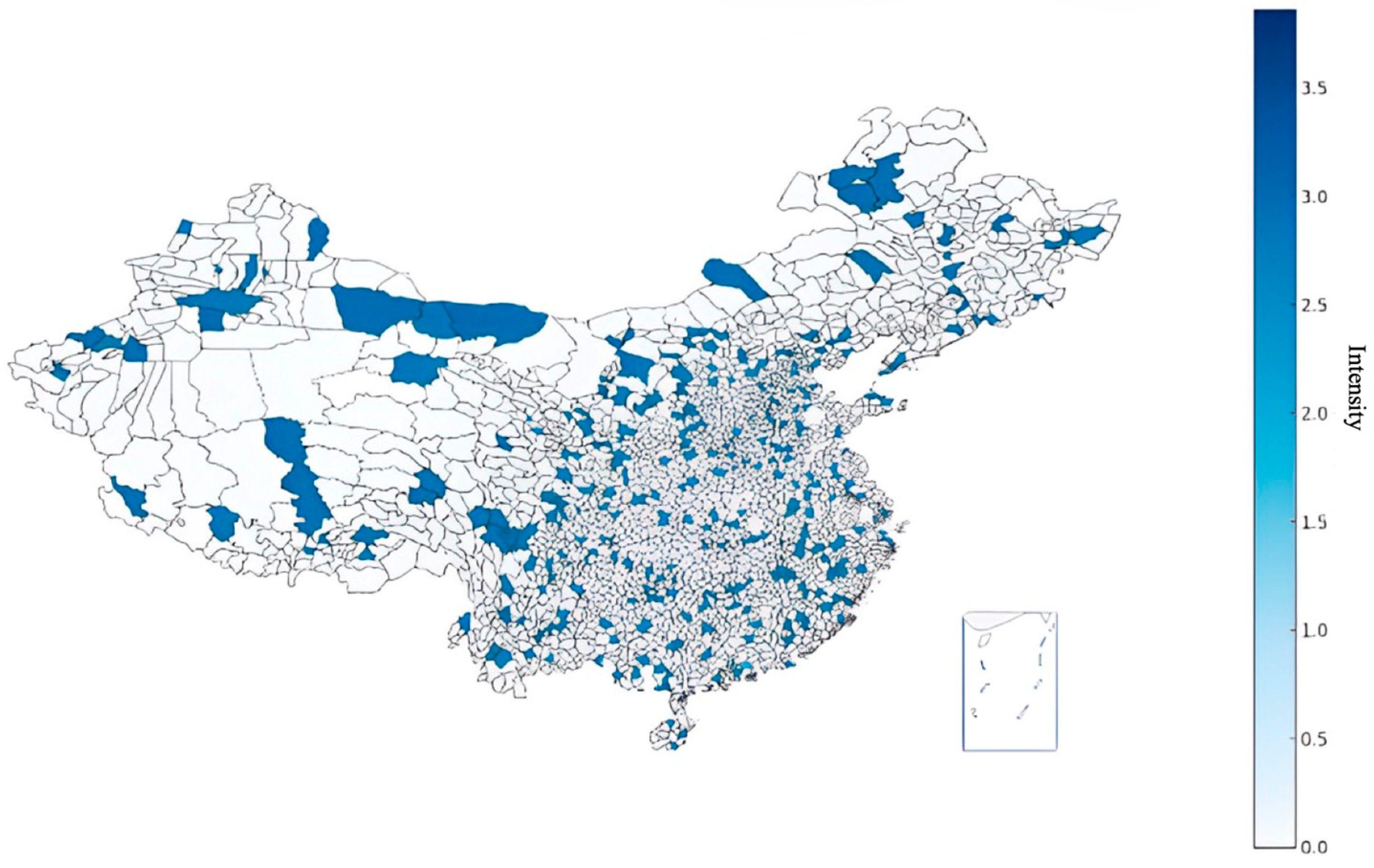
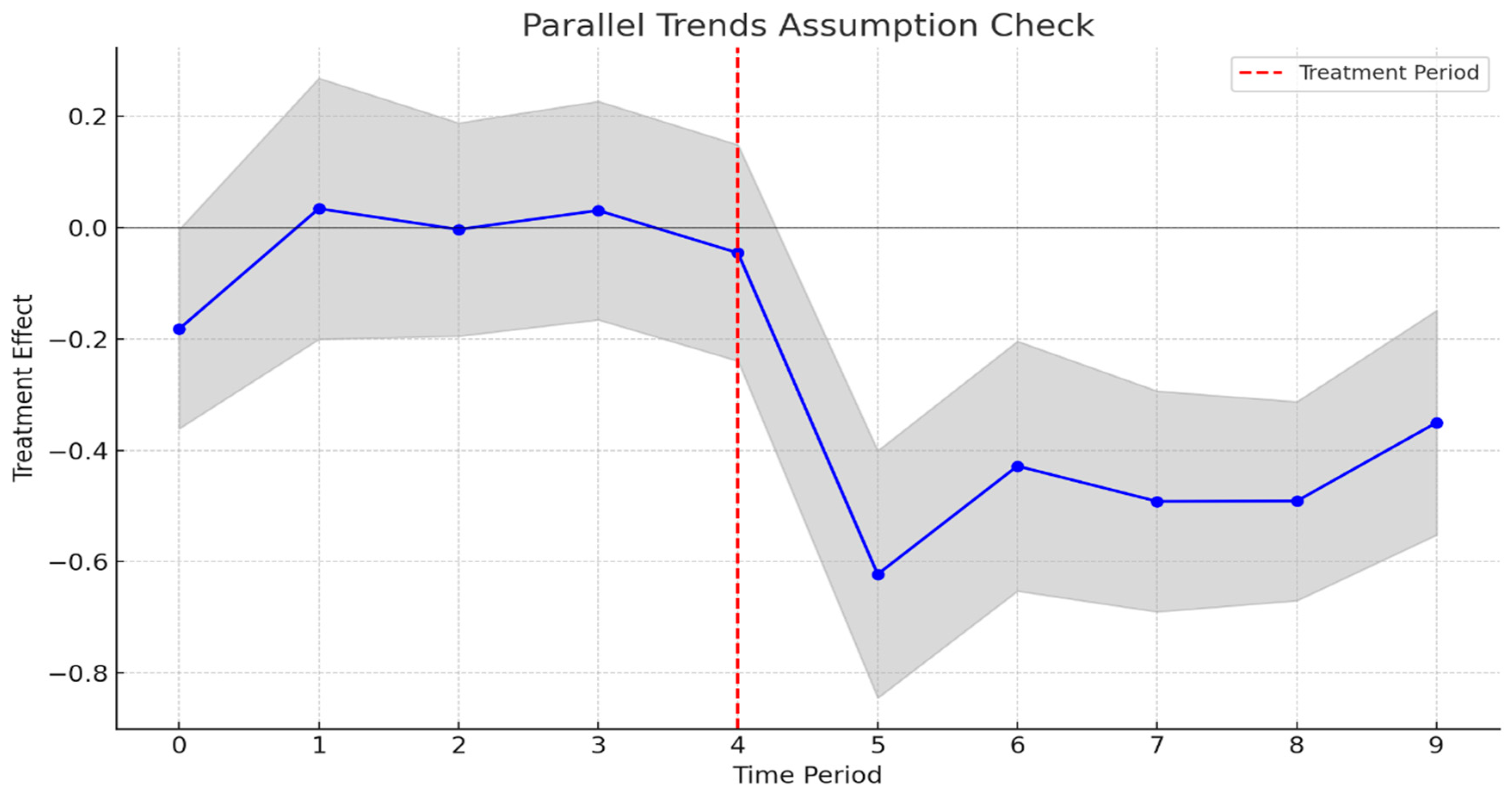

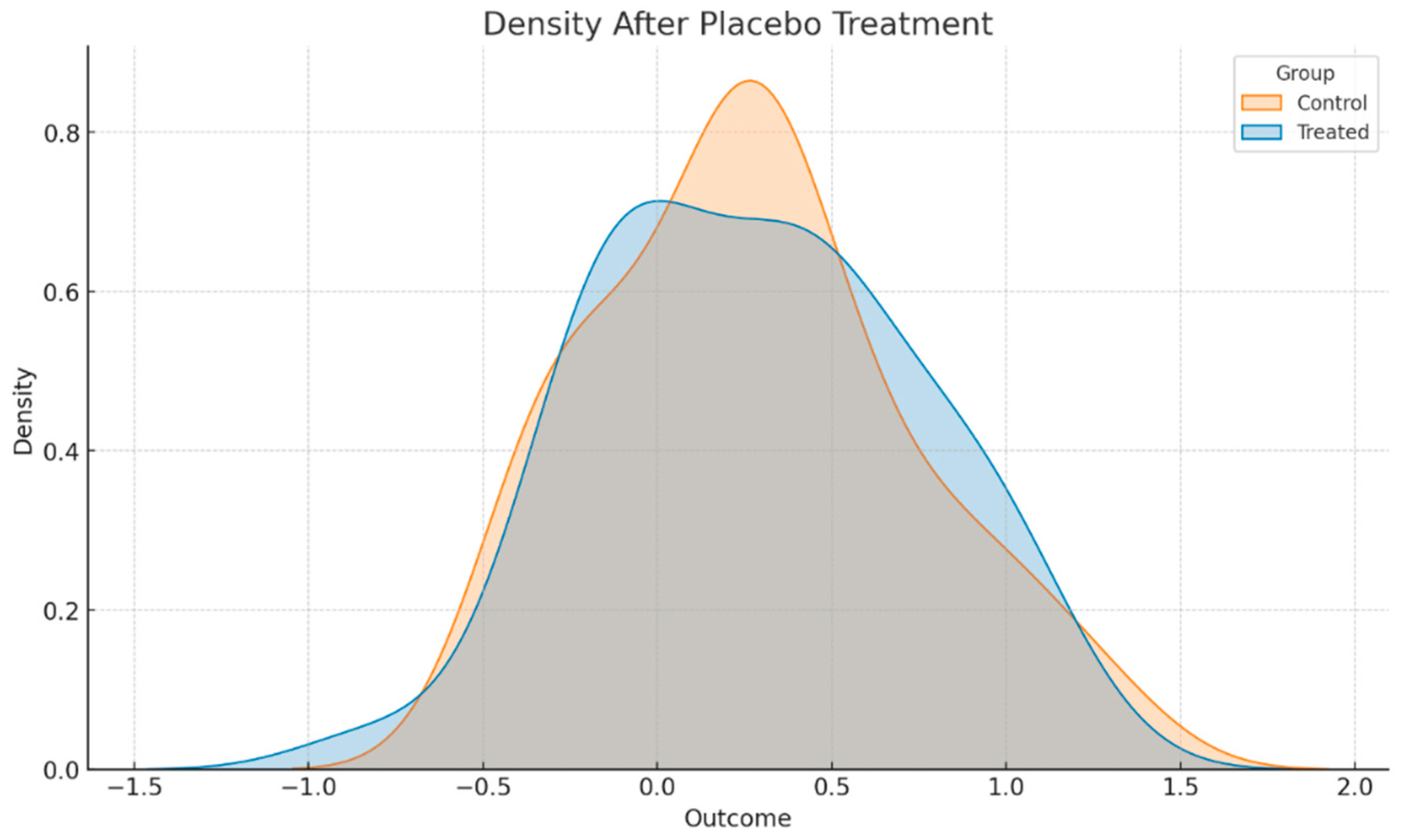

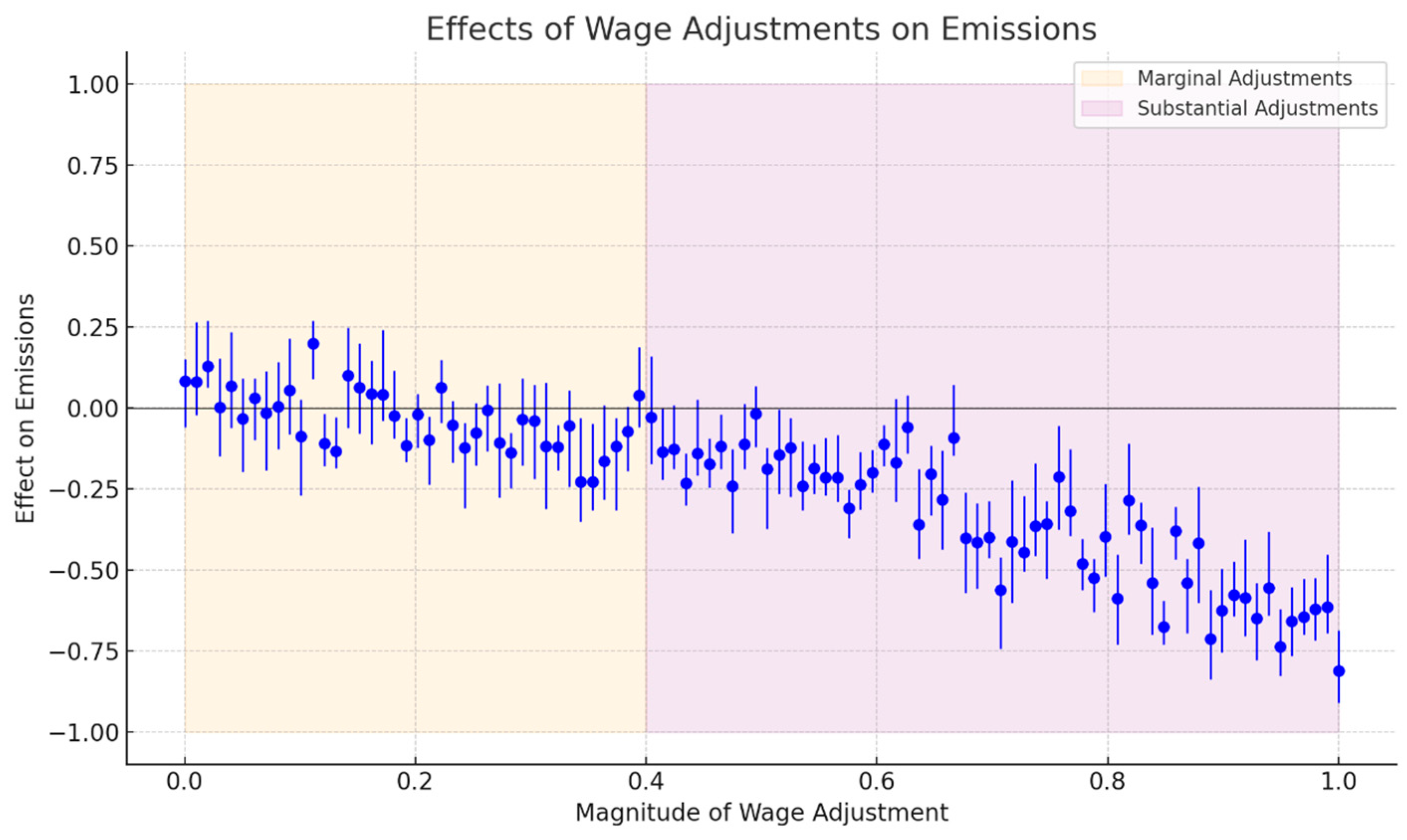

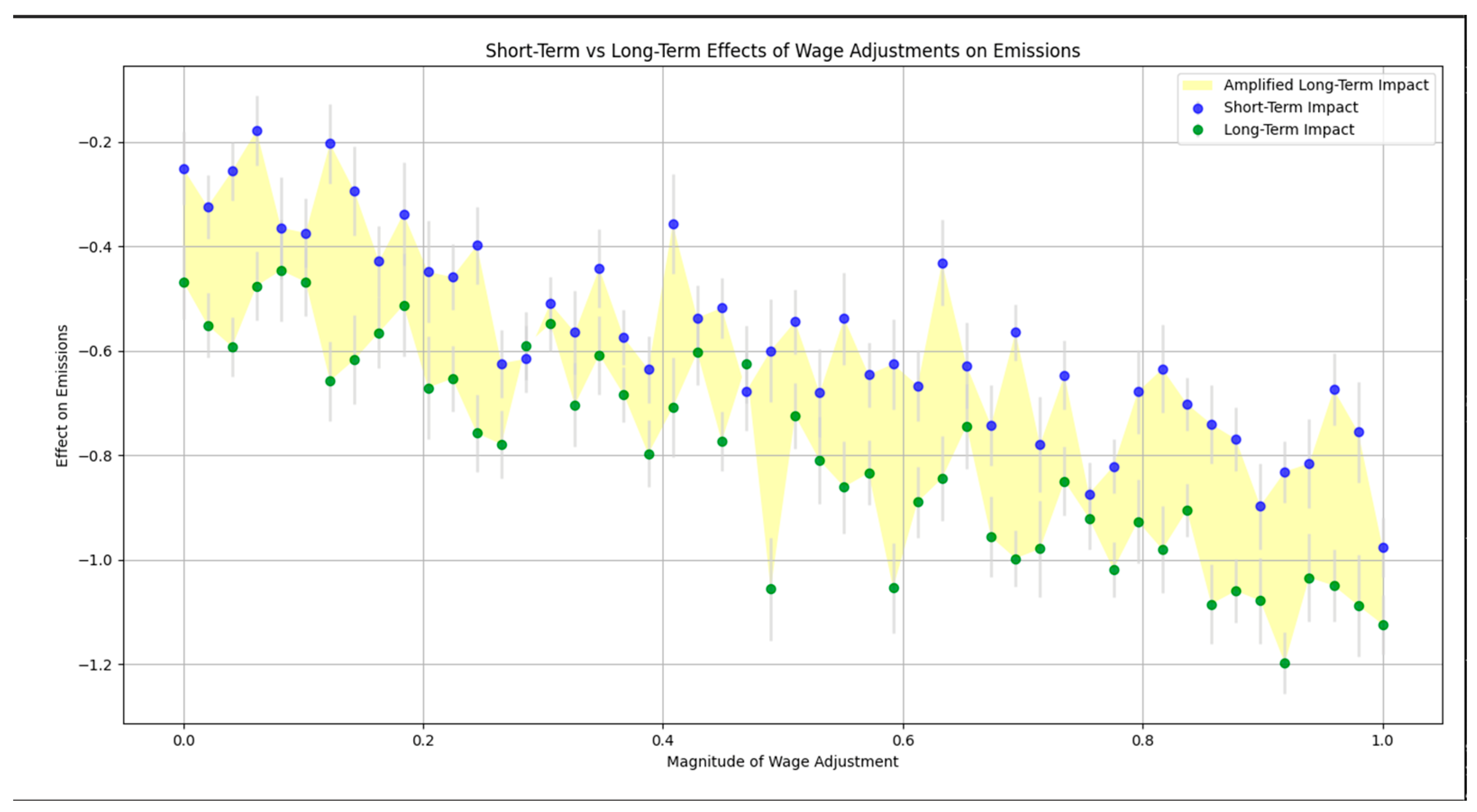
| Variable Name | Average | Standard Deviation | Min | Max | N |
|---|---|---|---|---|---|
| 0.3058 | 0.2015 | 0.4291 | 2.3514 | 19,384 | |
| 2.4460 | 7.1286 | 0.0464 | 64.0385 | 19,384 | |
| did | 0.1760 | 0.1131 | 0.0374 | 0.4333 | 19,384 |
| rd | 48.1854 | 8.7020 | 28.3300 | 66.4100 | 19,384 |
| Sk | 1.2886 | 0.5895 | 0.4380 | 3.3208 | 19,384 |
| sce | 0.0133 | 0.0113 | 0.0016 | 0.0424 | 19,384 |
| fne | 1.3300 | 1.2034 | 0.4697 | 9.6221 | 19,384 |
| Ffi | 0.0105 | 0.0133 | 0.0000 | 0.0613 | 19,384 |
| efu | 0.0405 | 0.0736 | 0.0009 | 0.4277 | 19,384 |
| Dcn | 0.0401 | 0.0329 | 0.0011 | 0.1185 | 19,384 |
| (1) | (2) | (3) | (4) | (5) | (6) | |
|---|---|---|---|---|---|---|
| Variables | Pollu | Pollu | Pollu | Pollu | Pollu | Pollu |
| did | −0.034 *** | −0.174 *** | −1.845 *** | −0.262 ** | −0.303 ** | −0.292 *** |
| (−3.83) | (−3.97) | (−12.70) | (−2.26) | (−2.52) | (−5.31) | |
| Control | N | Y | Y | Y | N | Y |
| city FE | Y | N | Y | N | Y | Y |
| id FE | Y | Y | Y | Y | Y | Y |
| Observations | 19,384 | 19,384 | 19,384 | 19,384 | 19,384 | 19,384 |
| R-squared | 0.821 | 0.479 | 0.592 | 0.384 | 0.031 | 0.178 |
| (1) | (2) | (3) | (4) | (5) | (6) | |
|---|---|---|---|---|---|---|
| Variables | Pollu | Pollu | Pollu | Pollu | Pollu | Pollu |
| did | −1.138 *** | −0.770 * | −0.607 ** | −1.391 *** | −1.386 *** | −1.210 *** |
| (−3.04) | (−1.85) | (−2.04) | (−6.08) | (−5.87) | (−4.18) | |
| Control | Y | Y | Y | Y | Y | Y |
| id FE | Y | Y | Y | Y | Y | Y |
| Year FE | Y | Y | Y | Y | Y | Y |
| Observations | 19,384 | 19,384 | 19,384 | 19,384 | 19,384 | 19,384 |
| R-squared | 0.592 | 0.732 | 0.086 | 0.384 | 0.031 | 0.178 |
| Test | Statistic |
|---|---|
| Hausmann Testing | 864.32 *** |
| DWH test | 69.57 *** |
| Weak correlation test | 83.82 *** |
| (1) | (2) | (3) | (4) | |
|---|---|---|---|---|
| Phase 1 | Phase 2 | |||
| Variables | Minimum Wage | Minimum Wage | ||
| iv | −0.267 *** | −0.268 *** | ||
| (−3.08) | (−3.10) | |||
| Did | −0.195 ** | −0.243 *** | ||
| (−2.41) | (−3.06) | |||
| Constant | 1.518 *** | 0.477 *** | ||
| (95.80) | (2.72) | |||
| city FE | N | Y | N | Y |
| id FE | Y | Y | Y | Y |
| Year FE | Y | Y | Y | Y |
| Observations | 19,384 | 19,384 | 19,384 | 19,384 |
| R-squared | 0.729 | 0.731 | 0.084 | 0.219 |
| (1) | (2) | (3) | (4) | (5) | (6) | (7) | (8) | (9) | |
|---|---|---|---|---|---|---|---|---|---|
| Variables | Pollu | Pollu | Pollu | Pollu | Pollu | Pollu | Pollu | Pollu | Pollu |
| did | −0.001 *** | −0.002 *** | −0.051 *** | −0.048 ** | −1.113 *** | −1.131 *** | −1.103 *** | −1.158 *** | −1.113 *** |
| (−2.71) | (−2.63) | (−2.60) | (−2.53) | (−9.43) | (−9.41) | (−7.01) | (−7.16) | (−9.43) | |
| Mechanism1 | 0.494 *** | 0.504 *** | 0.556 *** | ||||||
| (0.0250) | (0.0242) | (0.0262) | |||||||
| Mechanism2 | 4.850 *** | 4.821 *** | 5.343 *** | ||||||
| (2.73) | (3.86) | (4.36) | |||||||
| Mechanism3 | 0.193 *** | 0.314 *** | 0.155 *** | ||||||
| (0.0381) | (0.0382) | (0.0154) | |||||||
| Control | N | Y | Y | N | Y | Y | N | Y | Y |
| id FE | Y | N | Y | Y | N | Y | Y | N | Y |
| Year FE | Y | Y | Y | Y | Y | Y | Y | Y | Y |
| Observations | 19,384 | 19,384 | 19,384 | 19,384 | 19,384 | 19,384 | 19,384 | 19,384 | 19,384 |
| R-squared | 0.821 | 0.479 | 0.592 | 0.384 | 0.031 | 0.178 | 0.821 | 0.479 | 0.592 |
Disclaimer/Publisher’s Note: The statements, opinions and data contained in all publications are solely those of the individual author(s) and contributor(s) and not of MDPI and/or the editor(s). MDPI and/or the editor(s) disclaim responsibility for any injury to people or property resulting from any ideas, methods, instructions or products referred to in the content. |
© 2024 by the authors. Licensee MDPI, Basel, Switzerland. This article is an open access article distributed under the terms and conditions of the Creative Commons Attribution (CC BY) license (https://creativecommons.org/licenses/by/4.0/).
Share and Cite
Ren, H.; Zhu, M.; Lyu, B. Greening the Economy from the Ground Up: How the Minimum Wage Affects Firms’ Pollution Emissions in China. Sustainability 2024, 16, 6020. https://doi.org/10.3390/su16146020
Ren H, Zhu M, Lyu B. Greening the Economy from the Ground Up: How the Minimum Wage Affects Firms’ Pollution Emissions in China. Sustainability. 2024; 16(14):6020. https://doi.org/10.3390/su16146020
Chicago/Turabian StyleRen, Haili, Ming Zhu, and Bofei Lyu. 2024. "Greening the Economy from the Ground Up: How the Minimum Wage Affects Firms’ Pollution Emissions in China" Sustainability 16, no. 14: 6020. https://doi.org/10.3390/su16146020
APA StyleRen, H., Zhu, M., & Lyu, B. (2024). Greening the Economy from the Ground Up: How the Minimum Wage Affects Firms’ Pollution Emissions in China. Sustainability, 16(14), 6020. https://doi.org/10.3390/su16146020





